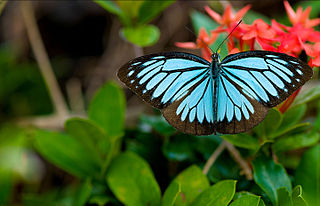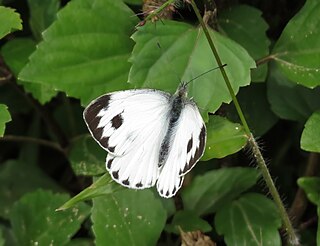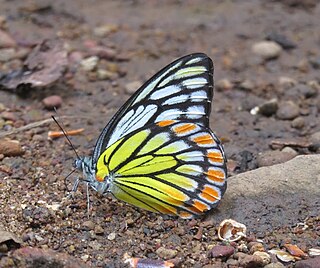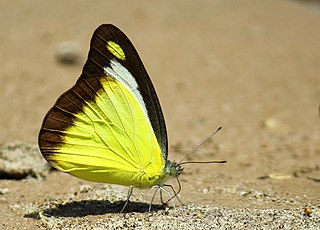
Cepora nerissa, the common gull, is a small to medium-sized butterfly of the family Pieridae, that is, the yellows and whites, which is native to Sri Lanka, India, China, southeast Asia, and Indonesia.

Pareronia valeria, the common wanderer or Malayan wanderer, is a medium-sized butterfly of the family Pieridae, that is, the yellows and whites, and is found in India and Southeast Asia. The butterfly found in India is sometimes considered as a separate species, Pareronia hippia.

Belenois aurota, the pioneer or pioneer white or caper white, is a small to medium-sized butterfly of the family Pieridae, that is, the yellows and whites, which is found in South Asia and Africa. In Africa, it is also known as the brown-veined white, and is well known during summer and autumn when large numbers migrate north-east over the interior.

Papilio buddha, the Malabar banded peacock, is a species of swallowtail butterfly found in the Western Ghats of India. The Government of Kerala declared it as the official Kerala state butterfly.

Aporia leucodice, the Himalayan blackvein, is a mid-sized to large butterfly of the family Pieridae, that is, the yellows and whites, which is found in India.

Pieris canidia, the Indian cabbage white, is a butterfly in the family Pieridae found in India, Nepal and Indochina. Pieris rapae is one of the most closely related species in the Pieridae.

Eurema brigitta, the small grass yellow or broad-bordered grass yellow, is a small butterfly of the family Pieridae, that is, the yellows and whites. It is found in India, other parts of Asia, Australia and Africa.

Eurema andersonii, the one-spot grass yellow or Anderson's grass yellow, is a small butterfly of the family Pieridae, that is, the yellows and whites, which is found in India, Myanmar and other parts of Asia.

Gandaca harina, the tree yellow, is a butterfly in the family Pieridae. It is found in India, Thailand, Cambodia, Myanmar, Malaysia, Singapore, Philippines, and Indonesia. The species was first described by Thomas Horsfield in 1829.

Prioneris sita, the painted sawtooth, is a small butterfly of the family Pieridae, that is, the yellows and whites, which is found in south India and Sri Lanka.

Delias sanaca, the pale Jezebel, is a medium-sized butterfly of the family Pieridae. The species was first described by Frederic Moore in 1857.

Appias indra, the plain puffin, is a small butterfly of the family Pieridae, that is, the yellows and whites, which is found in south and southeast Asia.

Appias libythea, the striped albatross, is a small butterfly of the family Pieridae, that is, the yellows and whites, which is found in south and southeast Asia.

Appias lyncida, the chocolate albatross, is a butterfly of the family Pieridae, that is, the yellows and whites, which is found in south and southeast Asia.

Appias wardii, the Indian albatross or Ward's albatross, is a small butterfly of the family Pieridae, that is, the yellows and whites, which is found in India.

Colias stoliczkana, the orange clouded yellow, is a small butterfly of the family Pieridae, that is, the yellows and whites, that is found in India.

Charles Thomas Bingham was an Irish military officer and entomologist.

Frederic Moore FZS was a British entomologist and illustrator. He produced six volumes of Lepidoptera Indica and a catalogue of the birds in the collection of the East India Company.

Lepidoptera Indica was a 10 volume work on the butterflies of the Indian region that was begun in 1890 and completed in 1913. It was published by Lovell Reeve and Co. of London. It has been considered the magnum opus of its author, Frederic Moore, assistant curator at the museum of the East India Company. Frederic Moore described a number of new species through this publication. Moore was a splitter, known for careless creation of synonyms, sometimes placing the same species in more than one genus.



















